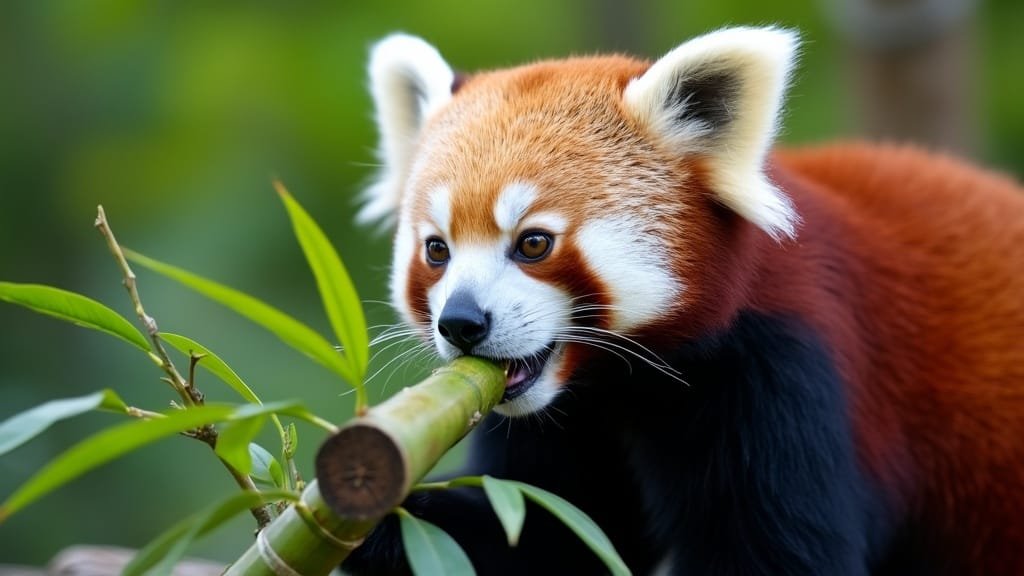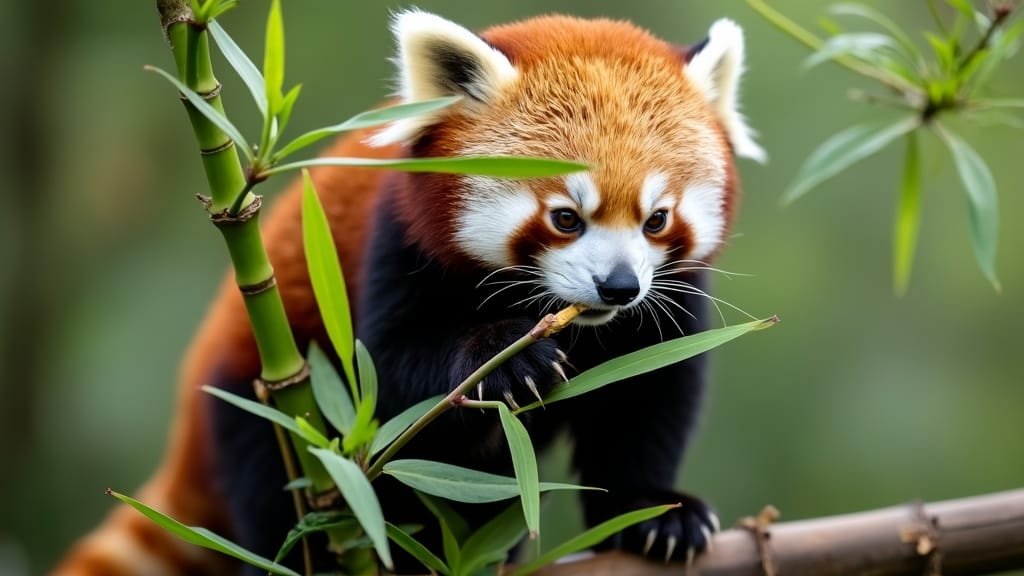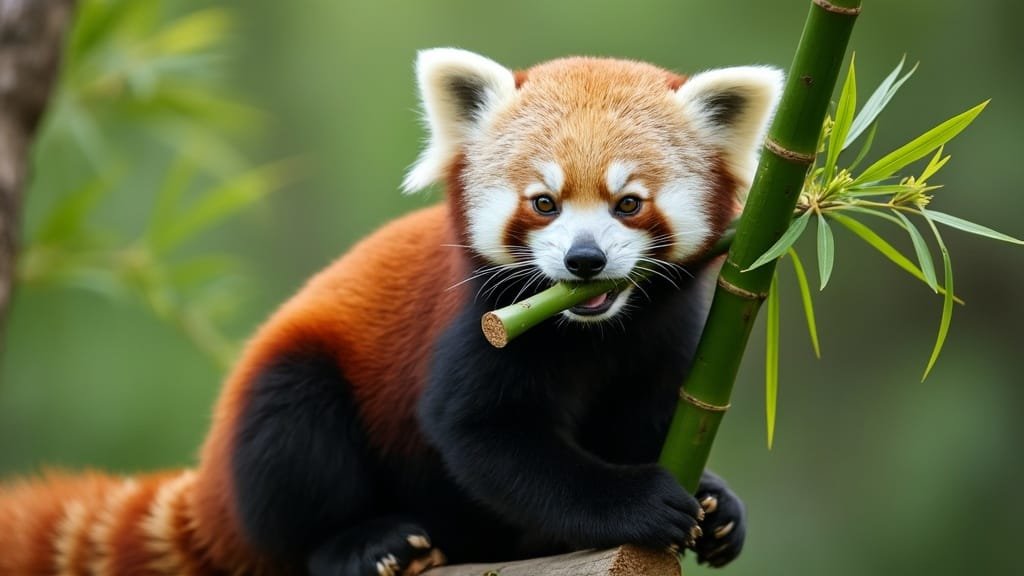Red pandas rely almost entirely on bamboo for their diet, consuming between 2.2 and 4.4 pounds (1 to 2 kg) daily. Since bamboo is low in calories and difficult to digest, red pandas must eat constantly, often spending up to 13 hours per day feeding. They primarily consume bamboo leaves and tender shoots, selecting the most nutrient-rich portions to maximize their energy intake
Despite their heavy dependence on bamboo, red pandas occasionally eat fruits, flowers, insects, and bird eggs, especially when bamboo is less nutritious or less available. Their unique digestive system and slow metabolism help them survive on a diet that provides minimal energy, but their reliance on bamboo makes them vulnerable to habitat loss and seasonal food shortages
This article explores how much bamboo red pandas consume daily, the nutritional challenges of a bamboo diet, and the adaptations that allow them to process large amounts of plant material. Additionally, we will compare their feeding habits to those of giant pandas and discuss how habitat loss threatens their primary food source
The Red Panda’s Dependence on Bamboo

Red pandas are highly specialized feeders, with bamboo making up the majority of their diet. Because bamboo is low in nutrients and difficult to digest, red pandas must consume large amounts every day to meet their energy needs. This reliance on a single food source influences their feeding behavior, metabolism, and survival strategies
Why Red Pandas Need to Eat So Much Bamboo
A red panda consumes between 2.2 and 4.4 pounds of bamboo daily, which is a significant amount for an animal that typically weighs between 6.5 and 14 pounds. The primary reason for this high intake is that bamboo has very little nutritional value. It is rich in fiber but low in protein, fats, and easily digestible carbohydrates. Unlike true herbivores, red pandas lack the specialized gut bacteria and multi-chambered stomachs needed to efficiently break down plant material, meaning that much of the bamboo they consume passes through their system undigested
To compensate for this inefficiency, red pandas must spend a large portion of their day eating. Their diet consists mostly of bamboo leaves, but they selectively consume the most tender and nutrient-rich parts of the plant. During the spring and summer, when bamboo shoots are available, they prioritize these because they contain higher levels of protein and water, making them easier to digest. As the seasons change and the availability of shoots decreases, red pandas shift to consuming more leaves and, in extreme cases, mature bamboo stems
A study by Wei et al. (Journal of Mammalogy, 2014) found that red pandas extract only about 24 percent of the available energy from bamboo, which is significantly lower than the digestive efficiency of herbivores such as deer or cattle. This means that they must eat large quantities of food to maintain their energy levels, a behavior that has shaped their daily routine and activity patterns
How Many Hours Per Day Do Red Pandas Spend Eating?
Due to bamboo’s low caloric value, red pandas must eat continuously throughout the day, often spending between 8 and 13 hours feeding. Unlike many other animals that consume large meals at once, red pandas eat small amounts frequently, ensuring a constant intake of nutrients. They alternate between feeding and resting, conserving energy whenever possible to offset the low efficiency of their diet
This feeding pattern is particularly important during colder months when food sources are more limited. In winter, red pandas may slightly increase their feeding time to compensate for the lower nutritional content of mature bamboo leaves. They also become less active, reducing unnecessary movement to conserve energy. Their ability to balance feeding with energy conservation is crucial for survival, especially in high-altitude environments where winter conditions can be harsh
Observations by Yonzon et al. (Biological Conservation, 1987) indicate that red pandas have adapted their feeding behavior to maximize efficiency. They often forage at dawn and dusk, taking advantage of cooler temperatures and lower competition from other herbivores. This crepuscular feeding pattern helps them avoid predators while ensuring a steady food intake
The Nutritional Challenges of a Bamboo-Based Diet
Bamboo provides very few essential nutrients, which makes it a challenging food source. While young bamboo shoots contain moderate amounts of protein and water, mature leaves and stems are composed mainly of cellulose and lignin, which red pandas struggle to digest. As a result, their energy intake varies depending on the season and the parts of the plant they are consuming
To adapt to these challenges, red pandas have evolved a slow metabolic rate that helps them survive on a low-calorie diet. Unlike highly active carnivorous relatives, red pandas conserve energy by limiting their movement and engaging in long rest periods between feeding sessions. Their small body size and thick fur also help retain body heat, reducing the amount of energy they need to maintain their internal temperature
Because their diet is so specialized, red pandas are highly vulnerable to food shortages. Bamboo forests undergo natural die-offs, where entire sections of a forest may flower, seed, and then die simultaneously. This phenomenon can leave red pandas without food for extended periods, forcing them to search for new feeding areas. Habitat destruction caused by deforestation and agriculture further threatens their food supply, making conservation efforts critical for their survival
For more information on how red pandas manage their bamboo-based diet, visit the San Diego Zoo’s red panda page
Bamboo Consumption and Feeding Patterns

Red pandas rely on a highly specialized diet, and their feeding habits reflect the challenges of extracting nutrients from bamboo. Their food preferences change with the seasons, and they exhibit selective feeding behavior to maximize energy intake. Additionally, comparing their bamboo consumption to that of giant pandas highlights key differences in their feeding strategies
What Parts of the Bamboo Plant Do Red Pandas Prefer?
Red pandas do not eat all parts of the bamboo plant equally. They selectively consume the most nutrient-rich portions, choosing bamboo shoots when available and favoring younger leaves over mature ones. Shoots are higher in protein, water, and digestible carbohydrates, making them the most desirable food source. They emerge in spring and early summer, providing red pandas with an essential boost in nutrition
As the seasons progress and bamboo shoots become less abundant, red pandas shift their diet to young bamboo leaves, which still contain moderate nutritional value but require more effort to chew and digest. In fall and winter, when shoots and tender leaves are scarce, they rely on mature leaves and stems, which are tougher, more fibrous, and less nutritious. Since mature leaves contain more cellulose and fewer digestible nutrients, red pandas must eat even greater quantities during these months to compensate for the lower energy intake
A study by Wei et al. (Journal of Mammalogy, 2014) found that red pandas adjust their feeding patterns based on bamboo quality, carefully selecting the most palatable parts to maintain energy efficiency. Their strong molars and jaw muscles help them crush bamboo fibers, making digestion easier, but their ability to extract nutrients remains limited compared to true herbivores
Seasonal Variations in Bamboo Intake
The amount of bamboo a red panda consumes daily is not constant and varies with seasonal changes in food availability. During spring and summer, when bamboo shoots are at their peak nutritional value, red pandas may consume slightly less total weight because shoots are more energy-dense. In contrast, during fall and winter, they eat more overall as they switch to mature leaves, which are lower in nutrients and harder to digest
A study by Yonzon et al. (Biological Conservation, 1987) observed that red pandas alter their feeding locations throughout the year, moving to areas where fresh bamboo growth is most abundant. This seasonal migration ensures they always have access to the most beneficial food sources. Additionally, during winter, red pandas lower their activity levels and metabolic rate, helping them survive on bamboo that provides fewer calories
In captivity, where bamboo quality is more consistent, red pandas exhibit fewer seasonal changes in diet. They are provided with a stable supply of high-quality bamboo, reducing the need for extreme seasonal dietary shifts
How Does Bamboo Consumption Compare to Giant Pandas?
Although both red pandas and giant pandas rely heavily on bamboo, their daily consumption and feeding strategies differ significantly due to differences in body size and metabolic needs
Red pandas, weighing between 6.5 and 14 pounds, consume 2.2 to 4.4 pounds of bamboo daily, which accounts for a significant portion of their body weight. In contrast, giant pandas, which can weigh up to 300 pounds, eat between 26 and 84 pounds of bamboo each day to sustain their much larger bodies
Despite their differences in size, both species exhibit similar inefficiencies in digesting bamboo. They extract only a small percentage of available nutrients, requiring them to eat for extended periods throughout the day. However, giant pandas have a larger digestive tract and longer retention time, allowing them to process slightly more fiber than red pandas
Another key difference is in feeding posture and technique. Giant pandas typically sit upright while feeding, using their powerful forelimbs to strip bamboo stalks. Red pandas, in contrast, use their pseudo-thumb to grasp bamboo stalks, often holding them like a raccoon while perched on a branch or the ground
Understanding these differences provides insight into how each species has adapted to a bamboo-dominated diet in distinct ways. For further comparisons, visit the Red Panda Network’s article on red panda vs. giant panda diets
Digestive and Physical Adaptations for Eating Bamboo

Red pandas have evolved a range of adaptations to help them survive on their bamboo-based diet. Unlike true herbivores, their digestive system is not fully optimized for processing plant material, which means they must consume large amounts of food daily to compensate for low energy absorption. Their physical adaptations, including strong teeth, specialized jaw muscles, and a pseudo-thumb, allow them to efficiently gather and consume bamboo. However, their digestive inefficiency limits the nutrients they can extract from their primary food source
How the Red Panda’s Digestive System Processes Bamboo
Red pandas have a relatively short digestive tract, which is more typical of carnivores than herbivores. Unlike ruminants such as cows or deer, which have multi-chambered stomachs and specialized gut bacteria to break down cellulose, red pandas lack the enzymes needed to fully digest bamboo fibers. As a result, they extract only about 24 percent of the available energy from bamboo, meaning much of what they consume passes through their system undigested
To compensate for this low digestive efficiency, red pandas eat frequently throughout the day, consuming up to 4.4 pounds of bamboo daily. Their digestive process is fast, with food passing through their system in as little as five hours. This rapid digestion allows them to process large quantities of food, but it also means they must continuously forage to meet their energy needs
A study by Wei et al. (Journal of Mammalogy, 2014) found that red pandas prioritize tender bamboo shoots and young leaves, which contain more protein and water and are easier to digest than mature leaves and stems. By selecting the most nutrient-dense parts of the plant, they maximize the limited energy they can extract from their diet
Specialized Physical Traits That Help Red Pandas Eat Bamboo
Red pandas have developed several physical adaptations that allow them to efficiently consume bamboo. One of their most distinctive features is their pseudo-thumb, an extended wrist bone that functions like a thumb. This adaptation enables them to grasp and manipulate bamboo stalks, much like a raccoon or a giant panda. The pseudo-thumb provides red pandas with better control when feeding, allowing them to hold bamboo in place while chewing
Their teeth and jaw structure have also evolved to handle a fibrous diet. Red pandas have large, flat premolars and molars, which are well-suited for crushing and grinding bamboo leaves. Their strong jaw muscles provide the necessary force to break down tough plant material, making it easier to swallow and digest. Additionally, their broad skull and short snout give them the bite strength needed to process large amounts of bamboo each day
Another important adaptation is their slow metabolic rate, which helps them survive on a low-energy diet. Red pandas conserve energy by reducing unnecessary movement and resting for long periods between meals. This strategy allows them to maintain body weight and function efficiently, even though their primary food source provides minimal calories
Why Red Pandas Lack the Digestive Efficiency of Herbivores
Despite relying almost entirely on bamboo, red pandas are not true herbivores and have not developed the specialized digestive adaptations seen in other plant-eating mammals. Unlike ruminants, which use fermentation to break down cellulose, red pandas rely on rapid digestion and selective feeding to obtain nutrients
This digestive inefficiency limits their ability to thrive on bamboo alone, making them more vulnerable to food shortages and habitat destruction. When bamboo forests decline due to deforestation or natural die-offs, red pandas may struggle to find enough food to survive. This dependence on a single food source highlights the importance of bamboo conservation efforts, as habitat loss directly threatens red panda populations
In captivity, red pandas are provided with a more balanced diet, including bamboo, fruits, specially formulated biscuits, and occasional protein sources such as mealworms or eggs. These additional food items help compensate for the nutritional deficiencies of bamboo, ensuring that captive red pandas receive adequate nutrition. For more details on their dietary adaptations, visit the San Diego Zoo Global Library’s red panda diet factsheet













